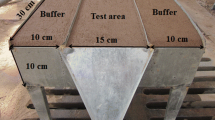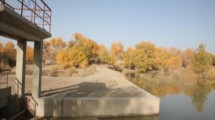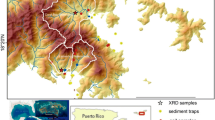Abstract
Purpose
The aim of our study was to characterise the heterogeneity of sediment distribution in a stormwater retention/infiltration basin (Pont de Cheviré, Nantes, France) and to determine the impact of this distribution on water transfer properties in the soil.
Materials and methods
Soil water retention curves and saturated hydraulic conductivity (K s) measurements were made at 11 points in the basin.
Results and discussion
A highly heterogeneous organic matter (OM) distribution ranging from 45 to 222 g kg−1 was observed in the surface layer (layer A), with a sediment thickness ranging from 5 to 26 cm. The sediment thickness of the underlying layer, primarily made up of sand (layer S), ranged from 7 to 32 g kg−1. We observed a significant influence of OM and fine mineral particles on the soil pore distribution and a negative correlation with the saturated hydraulic conductivity (values between 1.3e−5 and 7.2e−6 m s−1 in layer A and close to 3e−4 m s−1 in layer S).
Conclusions
This study allowed define the soil physical parameters that account for the clogging phenomenon in this infiltration basin. Nevertheless, this study raises questions as to the contribution of clay in the mineralogical sense on the one hand and OM dynamics on transfer properties and the clogging phenomenon on the other.






Similar content being viewed by others
References
Badin A-L, Faure P, Bedell J-P, Delolme C (2008) Distribution of organic pollutants and natural organic matter in urban storm water sediments as a function of grain size. Sci Total Environ 403:178–187
Badin A-L, Mederel G, Bechet B, Borschneck D, Delolme C (2009) Study of the aggregation of the surface layer of Technosols from stormwater infiltration basins using grain size analyses with laser diffractometry. Geoderma 153:163–171
Barraud S, Dechesne M, Bardin J, Varnier J (2005) Statistical analysis of pollution in stormwater infiltration basins. Water Sci Technol 51:1–9
Béchet B, Durin B, Lassabatère L, Ruban V, Legret M (2007) Rôle des bassins de rétention–infiltration dans l'épuration des eaux de ruissellement péri-urbaines. Récent Prog en Génie des Procédés 96:1–8
Blake GR, Hartge KH (1986) Particle density. In: Klute A (ed) Methods of soil analysis. Part 1. Physical and mineralogical methods. ASA and SSSA, Madison, pp 381–382
Bouwer H (1969) Theory of seepage from open channels. In: Press A (ed) Adv. in Hydrosciences. New York, pp 121–170
Braga A, Horst M, Traver RG (2007) Temperature effects on the infiltration rate through an infiltration basin BMP. J Irrig Drain Eng 133:593–601
Campbell CA (1978) Soil organic carbon, nitrogen and fertility. In: Schnitzer M, Khan SU (eds) Soil organic matter. Elsevier, Amsterdam, pp 173–271
Chocat B, Ashley R, Marsalek J, Matos MR, Rauch W, Schilling W, Urbonas B (2007) Towards the sustainable management of urban storm-water. Indoor Built Environ 16:273–285
Datry T, Malard F, Vitry L, Hervant F, Gibert J (2003) Solute dynamics in the bed sediments of a stormwater infiltration basin. J Hydrol 273:217–233
De Boodt M, Verdonck O, Cappaert I (1974) Method for measuring the water-release curve of organic substrates. Acta Hortic 37:2054–2062
Dechesne M, Barraud S, Bardin JP (2004) Indicators for hydraulic and pollution retention assessment of stormwater infiltration basins. J Environ Manage 71:371–380
Delmas-Gadras C (2000) Influence des conditions physico-chimiques sur la mobilité du plomb et du zinc dans un sol et un sédiment routier, Thesis. Pau and Pays de l'Adour University, Pau, France
Dexter AR (2004) Soil physical quality—Part I. Theory, effects of soil texture, density, and organic matter, and effects on root growth. Geoderma 120:201–214
Dexter AR, Bird NRA (2001) Methods for predicting the optimum and the range of water contents for tillage based on the water retention curve. Soil Till Res 57:203–212
Durand C, Ruban V, Amblès A (2005) Characterisation of complex organic matter present in contaminated sediments from water retention ponds. J Anal Appl Pyrol 73:17–28
Durin B (2006) Transfert et transport colloïdal de polluants métalliques: applications en assainissement routier. Nantes University, Nantes, p 394
Durin B, Béchet B, Legret M, Le Cloirec P (2007) Role of colloids in heavy metal transfer through a retention–infiltration basin. Water Sci Technol 56:91–99
Gonzalez-Sosa E, Braud I, Dehotin J, Lassabatère L, Angulo-Jaramillo R, Lagouy M, Branger F, Jacqueminet C, Kermadi S, Michel K (2010) Impact of land use on the hydraulic properties of the topsoil in a small French catchment. Hydrol Process (in press)
Hamza M, Anderson WK (2005) Soil compaction in cropping systems—a review of the nature, causes and possible solutions. Soil Till Res 82:121–145
Ishizaki K, Imbe M, Ni G, Takeshima M (1996) Background of rainwater infiltration technology. 7th International Conference on Urban Storm Drainage, Hannover, Germany, pp 377–382
Lassabatere L, Angulo-Jaramillo R, Ugalde JMS, Cuenca R, Braud I, Haverkamp R (2006) Beerkan estimation of soil transfer parameters through infiltration experiments—BEST. Soil Sci Soc Am J 70:521–532
Lassabatere L, Angulo-Jaramillo R, Soria Ugalde JM, Simunek J, Haverkamp R (2009) Analytical and numerical modeling of water infiltration experiments. Water Resour Res 45:W12415
Lassabatere L, Angulo-Jaramillo R, Goutaland D, Letellier L, Gaudet JP, Winiarski T, Delolme C (2010) Effect of the settlement of sediments on water infiltration in two urban infiltration basins. Geoderma 156(3–4):316–325
Le Coustumer S, Barraud S (2007) Long-term hydraulic and pollution retention performance of infiltration systems 7th International Conference on Urban Drainage Modelling/4th International Conference on Water Sensitive Urban Design, Date: APR 02-07, 2006 Melbourne AUSTRALIA. Water Sci Technol 55:235–243
Legret M, Pagotto C (1999) Evaluation of pollutant loadings in the runoff waters from a major rural highway. Sci Total Environ 235:143–150
Legret M, Le Marc C, Demare D, Colandini V (1995) Heavy metal pollution in a detention pond receiving highway run-off. Environ Technol 16:1049–1060
Lerner DN, Issar AS, Simmers I (1990) Groundwater recharge: a guide to understanding and estimating natural recharge. International Contribution to Hydrogeology. Verlag Heinz Heise, Hannover
Musy A, Soutter M (1991) Physique du sol. Presses Polytechniques et Universitaires Romandes, Lausanne, p 335
Nelson DW, Sommers LE (1996) Total carbon, organic carbon and organic matter. Methods of soil analysis. Part 3. Chemical methods. Soil Sci Soc Am J, Madison, pp 961–1010
Nimmer M, Thompson A, Misra D (2009) Water table mounding beneath stormwater infiltration basins. Environ Eng Geosci 15:67–79
Pilgrim W, Schroder B (1997) Multi-media concentrations of heavy metals and major ions from urban and rural sites in New Brunswick, Canada. Environ Monit Assess 47:89–108
Pitt R, Clark S, Field R (1999) Groundwater contamination potential from stormwater infiltration practices. Urban Water 1:217–236
Richards LA (1947) A pressure-membrane apparatus construction and use. Agric Eng 28:451–454
Schuh WM (1990) Seasonal variation of clogging of an artificial recharge basin in a northern climate. J Hydrol 121:193–215
van Genuchten MT (1980) A closed-form equation for predicting hydraulic conductivity of unsaturated soils. Soil Sci Soc Am J 44:892–898
Winiarski T, Bedell J-P, Delolme C, Perrodin Y (2006) The impact of stormwater on a soil profile in an infiltration basin. Hydrogeol J 14:1244–1251
Yilmaz D, Lassabatere L, Angulo-Jaramillo R, Legret M (2010) Hydrodynamic characterization of BOF slags through adapted BEST method. Vadoze Zone J 9:107–116
Zhang H (1994) Organic matter incorporation affects mechanical properties of soil aggregates. Soil Tillage Res 31:263–275
Zhang RD (1997) Determination of soil sorptivity and hydraulic conductivity from the disk infiltrometer. Soil Sci Soc Am J 61:1024–1030
Acknowledgements
This study was carried out within the EPHor research unit at Agrocampus Ouest, Centre of Angers. It was conducted within the framework of the regional Polesur Project from 2008 to 2011. The authors would like to thank all of the people who contributed to this work. First, special thanks are in order for the DIR Ouest who gave us permission to work at the Pont de Cheviré infiltration basin. Second, we would like to express our gratitude to Stevens Burgaud for data collection and processing, and to Claudie Mazzega, Yvette Barraud-Roussel and Sylviane Delepine-Bourgeois who were responsible for the laboratory measurements.
Author information
Authors and Affiliations
Corresponding author
Additional information
Responsible editor: Ying Ouyang
Rights and permissions
About this article
Cite this article
Cannavo, P., Vidal-Beaudet, L., Béchet, B. et al. Spatial distribution of sediments and transfer properties in soils in a stormwater infiltration basin. J Soils Sediments 10, 1499–1509 (2010). https://doi.org/10.1007/s11368-010-0258-7
Received:
Accepted:
Published:
Issue Date:
DOI: https://doi.org/10.1007/s11368-010-0258-7




